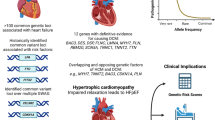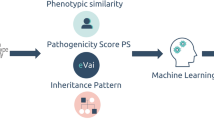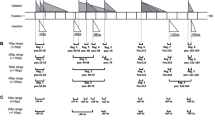Abstract
Atrial fibrillation (AF) affects more than 5 million people worldwide; however, none of the anti-arrhythmic drugs available now are entirely optimal in terms of efficacy and safety. A better understanding of the molecular mechanism of AF will facilitate the process of finding new strategies to prevent AF. As the non-familial AF is the major form of AF, identifying common variants for AF in these populations by genome-wide association studies will definitely accelerate this process. This review summarizes the recently identified common AF variants on 4q25, 16q22, and 1q21 and discusses their implications for the clinic.




Similar content being viewed by others
References
Anselmi CV, Novelli V, Roncarati R et al (2008) Association of rs2200733 at 4q25 with atrial flutter/fibrillation diseases in an Italian population. Heart 94:1394–1396
Benjamin EJ, Rice KM, Arking DE et al (2009) Variants in ZFHX3 are associated with atrial fibrillation in individuals of European ancestry. Nat Genet 41:879–881
Bhuiyan ZA, van den Berg MP, van Tintelen JP et al (2007) Expanding spectrum of human RYR2-related disease: new electrocardiographic, structural, and genetic features. Circulation 116:1569–1576
Body SC, Collard CD, Shernan SK et al (2009) Variation in the 4q25 chromosomal locus predicts atrial fibrillation after coronary artery bypass graft surgery. Circ Cardiovasc Genet 2:499–506
Brugada R, Hong K, Dumaine R et al (2004) Sudden death associated with short-QT syndrome linked to mutations in HERG. Circulation 109:30–35
Chen YH, Xu SJ, Bendahhou S et al (2003) KCNQ1 gain-of-function mutation in familial atrial fibrillation. Science 299:251–254
Cheng Y, Zhan Q, Zhao J, Xiao J (2010) Stabilizing ryanodine receptor type 2: a novel strategy for the treatment of atrial fibrillation. Med Sci Monit 16:HY23–HY26
Chinchilla A, Daimi H, Lozano-Velasco E et al (2011) Pitx2 insufficiency leads to atrial electrical and structural remodeling linked to arrhythmogenesis. Circ Cardiovasc Genet 4:269–279
Ellinor PT, Nam EG, Shea MA, Milan DJ, Ruskin JN, MacRae CA (2008) Cardiac sodium channel mutation in atrial fibrillation. Heart Rhythm 5:99–105
Ellinor PT, Lunetta KL, Glazer NL et al (2010) Common variants in KCNN3 are associated with lone atrial fibrillation. Nat Genet 42:240–244
Gollob MH, Jones DL, Krahn AD et al (2006) Somatic mutations in the connexin 40 gene (GJA5) in atrial fibrillation. N Engl J Med 354:2677–2688
Gretarsdottir S, Thorleifsson G, Manolescu A et al (2008) Risk variants for atrial fibrillation on chromosome 4q25 associate with ischemic stroke. Ann Neurol 64:402–409
Gudbjartsson DF, Arnar DO, Helgadottir A et al (2007) Variants conferring risk of atrial fibrillation on chromosome 4q25. Nature 448:353–357
Gudbjartsson DF, Holm H, Gretarsdottir S et al (2009) A sequence variant in ZFHX3 on 16q22 associates with atrial fibrillation and ischemic stroke. Nat Genet 41:876–878
Hodgson-Zingman DM, Karst ML, Zingman LV et al (2008) Atrial natriuretic peptide frameshift mutation in familial atrial fibrillation. N Engl J Med 359:158–165
Hong K, Piper DR, Diaz-Valdecantos A et al (2005) De novo KCNQ1 mutation responsible for atrial fibrillation and short QT syndrome in utero. Cardiovasc Res 68:433–440
Husser D, Adams V, Piorkowski C, Hindricks G, Bollmann A (2010) Chromosome 4q25 variants and atrial fibrillation recurrence after catheter ablation. J Am Coll Cardiol 55:747–753
Kaab S, Darbar D, van Noord C et al (2009) Large scale replication and meta-analysis of variants on chromosome 4q25 associated with atrial fibrillation. Eur Heart J 30:813–819
Kirchhof P, Kahr PC, Kaese S et al (2011) Pitx2c is expressed in the adult left atrium, and reducing pitx2c expression promotes atrial fibrillation inducibility and complex changes in gene expression. Circ Cardiovasc Genet 4:123–133
Lee KT, Yeh HY, Tung CP et al (2010) Association of RS2200733 but not RS10033464 on 4q25 with atrial fibrillation based on the recessive model in a Taiwanese population. Cardiology 116:151–156
Lemmens R, Buysschaert I, Geelen V et al (2010) The association of the 4q25 susceptibility variant for atrial fibrillation with stroke is limited to stroke of cardioembolic etiology. Stroke 41:1850–1857
Li C, Wang F, Yang Y et al (2011) Significant association of SNP rs2106261 in the ZFHX3 gene with atrial fibrillation in a Chinese Han GeneID population. Hum Genet 129:239–246
Lubitz SA, Sinner MF, Lunetta KL et al (2010) Independent susceptibility markers for atrial fibrillation on chromosome 4q25. Circulation 122:976–984
Makiyama T, Akao M, Shizuta S et al (2008) A novel SCN5A gain-of-function mutation M1875T associated with familial atrial fibrillation. J Am Coll Cardiol 52:1326–1334
Olson TM, Michels VV, Ballew JD et al (2005) Sodium channel mutations and susceptibility to heart failure and atrial fibrillation. Jama 293:447–454
Olson TM, Alekseev AE, Liu XK et al (2006) Kv1.5 channelopathy due to KCNA5 loss-of-function mutation causes human atrial fibrillation. Hum Mol Genet 15:2185–2191
Olson TM, Alekseev AE, Moreau C et al (2007) KATP channel mutation confers risk for vein of Marshall adrenergic atrial fibrillation. Nat Clin Pract Cardiovasc Med 4:110–116
Postma AV, van de Meerakker JB, Mathijssen IB et al (2008) A gain-of-function TBX5 mutation is associated with atypical Holt-Oram syndrome and paroxysmal atrial fibrillation. Circ Res 102:1433–1442
Qi J, Xiao J, Zhang Y et al (2009) Effects of potassium channel blockers on changes in refractoriness of atrial cardiomyocytes induced by stretch. Exp Biol Med (Maywood) 234:779–784
Quentien MH, Vieira V, Menasche M et al (2010) Truncation of PITX2 differentially affects its activity on physiological targets. J Mol Endocrinol 46:9–19
Ravn LS, Aizawa Y, Pollevick GD et al (2008) Gain of function in IKs secondary to a mutation in KCNE5 associated with atrial fibrillation. Heart Rhythm 5:427–435
Shi L, Li C, Wang C et al (2009) Assessment of association of rs2200733 on chromosome 4q25 with atrial fibrillation and ischemic stroke in a Chinese Han population. Hum Genet 126:843–849
Sinner MF, Ellinor PT, Meitinger T, Benjamin EJ, Kaab S (2011) Genome-wide association studies of atrial fibrillation: past, present, and future. Cardiovasc Res 89:701–709
Thibodeau IL, Xu J, Li Q et al (2010) Paradigm of genetic mosaicism and lone atrial fibrillation: physiological characterization of a connexin 43-deletion mutant identified from atrial tissue. Circulation 122:236–244
Virani SS, Brautbar A, Lee W et al (2011) Usefulness of single nucleotide polymorphism in chromosome 4q25 to predict in-hospital and long-term development of atrial fibrillation and survival in patients undergoing coronary artery bypass grafting. Am J Cardiol 107:1505–1509
Wang J, Klysik E, Sood S, Johnson RL, Wehrens XH, Martin JF (2010) Pitx2 prevents susceptibility to atrial arrhythmias by inhibiting left-sided pacemaker specification. Proc Natl Acad Sci USA 107:9753–9758
Watanabe H, Darbar D, Kaiser DW et al (2009) Mutations in sodium channel beta1- and beta2-subunits associated with atrial fibrillation. Circ Arrhythm Electrophysiol 2:268–275
Xia M, Jin Q, Bendahhou S et al (2005) A Kir2.1 gain-of-function mutation underlies familial atrial fibrillation. Biochem Biophys Res Commun 332:1012–1019
Xiao J, Liang D, Zhao H et al (2010a) 2-Aminoethoxydiphenyl borate, a inositol 1, 4, 5-triphosphate receptor inhibitor, prevents atrial fibrillation. Exp Biol Med (Maywood) 235:862–868
Xiao J, Zhang H, Liang D et al (2010b) Taxol, a microtubule stabilizer, prevents atrial fibrillation in in vitro atrial fibrillation models using rabbit hearts. Med Sci Monit 16:BR353–BR360
Xiao JJ, Liang DD, Chen YH (2011) The genetics of atrial fibrillation: from the bench to the besides. Annu Rev Genomics Hum Genet 12:6.1–6.24
Xiao J, Liang D, Zhang Y, et al. (2011) MicroRNA expression signature in atrial fibrillation with mitral stenosis. Physiol Genomics 43:655–664
Yang Y, Xia M, Jin Q et al (2004) Identification of a KCNE2 gain-of-function mutation in patients with familial atrial fibrillation. Am J Hum Genet 75:899–905
Zhang DF, Liang B, Lin J, Liu B, Zhou QS, Yang YQ (2005) KCNE3 R53H substitution in familial atrial fibrillation. Chin Med J (Engl) 118:1735–1738
Zhang X, Chen S, Yoo S et al (2008) Mutation in nuclear pore component NUP155 leads to atrial fibrillation and early sudden cardiac death. Cell 135:1017–1027
Acknowledgments
This work was supported by the Shanghai Municipal Natural Science Foundation (10ZR1433100, to Xingyuan Liu).
Conflict of interest
None.
Author information
Authors and Affiliations
Corresponding authors
Additional information
X. Liu, F. Wang, J. Xiao and J. Zhao contributed equally to this work.
Rights and permissions
About this article
Cite this article
Liu, X., Wang, F., Knight, A.C. et al. Common variants for atrial fibrillation: results from genome-wide association studies. Hum Genet 131, 33–39 (2012). https://doi.org/10.1007/s00439-011-1052-3
Received:
Accepted:
Published:
Issue Date:
DOI: https://doi.org/10.1007/s00439-011-1052-3




